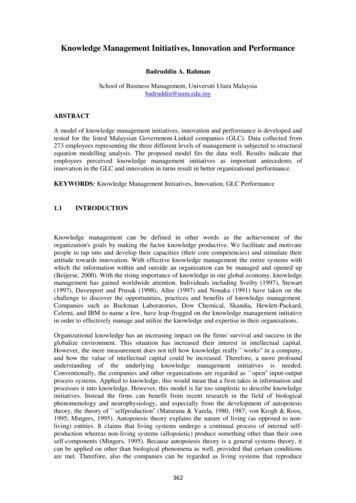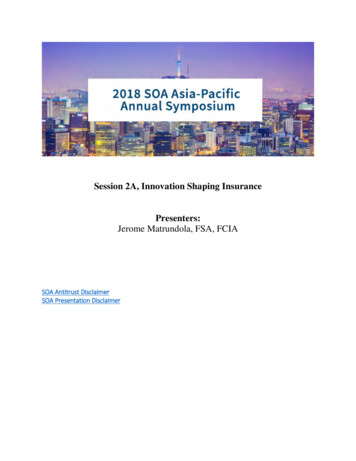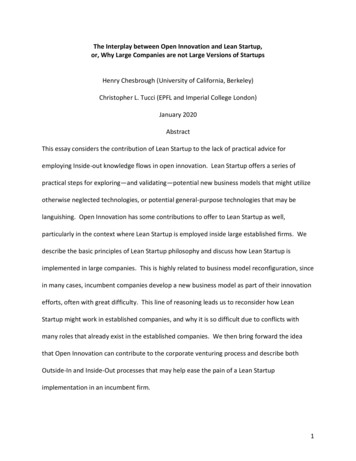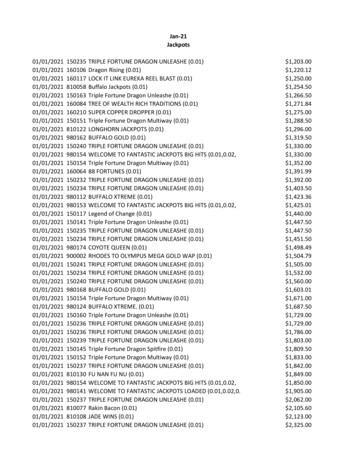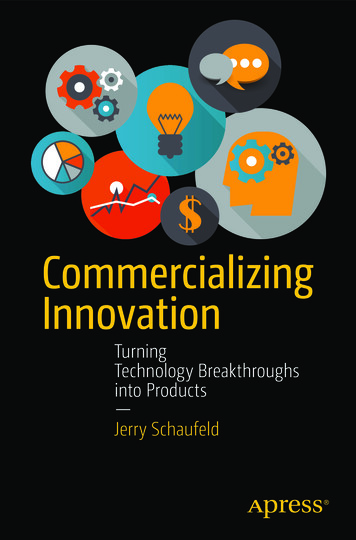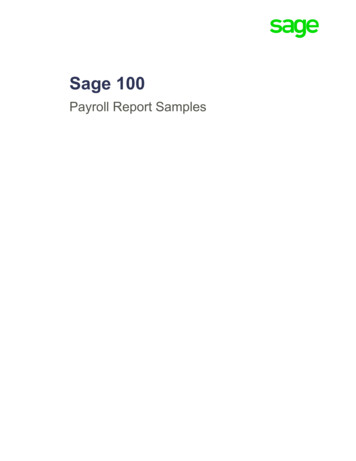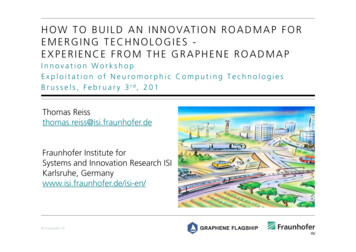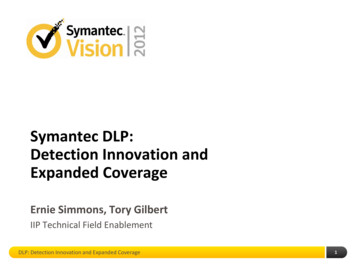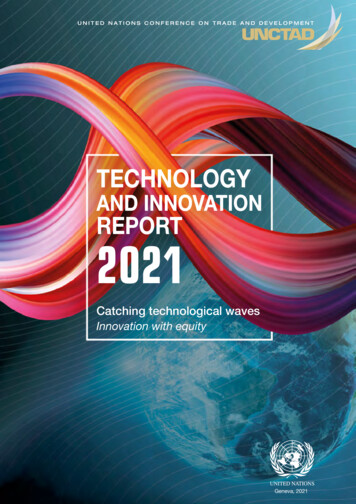
Transcription
U N I T E D N AT I O N S C O N F E R E N C E O N T R A D E A N D D E V E L O P M E N TTECHNOLOGYAND INNOVATIONREPORT2021Catching technological wavesInnovation with equityGeneva, 2021
2021, United NationsAll rights reserved worldwideRequests to reproduce excerpts or to photocopy should be addressed to the Copyright ClearanceCenter at copyright.com.All other queries on rights and licences, including subsidiary rights, should be addressed to:United Nations Publications405 East 42nd StreetNew York, New York 10017United States of AmericaEmail: publications@un.orgWebsite: https://shop.un.org/The designations employed and the presentation of material on any map in this work do not imply theexpression of any opinion whatsoever on the part of the United Nations concerning the legal statusof any country, territory, city or area or of its authorities, or concerning the delimitation of its frontiersor boundaries.This publication has been edited externally.United Nations publication issued by the United Nations Conference on Trade and Development.UNCTAD/TIR/2020ISBN: 978-92-1-113012-6eISBN: 978-92-1-005658-8ISSN: 2076-2917eISSN: 2224-882XSales No. E.21.II.D.8iiTECHNOLOGY AND INNOVATION REPORT 2021
CATCHING TECHNOLOGICAL WAVESInnovation with equityNOTEWithin the UNCTAD Division on Technology and Logistics, the STI Policy Section carries out policyoriented analytical work on the impact of innovation and new and emerging technologies on sustainabledevelopment, with a particular focus on the opportunities and challenges for developing countries. Itis responsible for the Technology and Innovation Report, which seeks to address issues in science,technology and innovation that are topical and important for developing countries, and to do so ina comprehensive way with an emphasis on policy-relevant analysis and conclusions. The STI PolicySection supports the integration of STI in national development strategies and in building up STIpolicy-making capacity in developing countries; a major instrument in this area is the programme ofScience, Technology and Innovation Policy Reviews. The section also serves as the core secretariatof the United Nations Commission on Science and Technology for Development (CSTD).In this report, the terms country/economy refer, as appropriate, to territories or areas. The designationsof country groups are intended solely for statistical or analytical convenience and do not necessarilyexpress a judgement about the stage of development reached by a particular country or area in thedevelopment process. Unless otherwise indicated, the major country groupings used in this reportfollow the classification of the United Nations Statistical Office. These are:Developed countries: the member countries of the Organisation for Economic Co-operation andDevelopment (OECD) (other than Chile, Mexico, the Republic of Korea and Turkey), plus the EuropeanUnion member countries that are not OECD members (Bulgaria, Croatia, Cyprus, Lithuania, Maltaand Romania), plus Andorra, Liechtenstein, Monaco and San Marino. Countries with economiesin transition refers to those of South-East Europe and the Commonwealth of Independent States.Developing economies, in general, are all the economies that are not specified above. For statisticalpurposes, the data for China do not include those for the Hong Kong Special Administrative Region ofChina (Hong Kong, China), Macao Special Administrative Region of China (Macao, China) or TaiwanProvince of China. An Excel file with the main country groupings used can be downloaded fromUNCTADstat at: ml.References to sub-Saharan Africa include South Africa unless otherwise indicated.References in the text to the United States are to the United States of America and those to theUnited Kingdom are to the United Kingdom of Great Britain and Northern Ireland.The term “dollar” ( ) refers to United States dollar, unless otherwise stated.The term “billion” signifies 1,000 million.Annual rates of growth and change refer to compound rates.Use of a dash (–) between dates representing years, such as 1988–1990, signifies the full periodinvolved, including the initial and final years.An oblique stroke (/) between two years, such as 2000/01, signifies a fiscal or crop year.A dot (.) in a table indicates that the item is not applicable.Two dots (.) in a table indicate that the data are not available, or are not separately reported.A dash (–) or a zero (0) in a table indicates that the amount is nil or negligible.Decimals and percentages do not necessarily add up to totals because of rounding.iiiTECHNOLOGY AND INNOVATION REPORT 2021
CATCHING TECHNOLOGICAL WAVESInnovation with equityFOREWORDRecent developments in frontier technologies, including artificial intelligence, robotics and biotechnology,have shown tremendous potential for sustainable development. Yet, they also risk increasing inequalitiesby exacerbating and creating new digital divides between the technology haves and have-nots. TheCOVID-19 pandemic has further exposed this dichotomy. Technology has been a critical tool for addressingthe spread of the disease, but not everyone has equal access to the benefits.It is time to ask how we can take full profit from the current technological revolution to reduce gaps thathold back truly inclusive and sustainable development. The UNCTAD Technology and Innovation Report2021 examines the likelihood of frontier technologies widening existing inequalities and creating newones. It also addresses the national and international policies, instruments and institutional reforms thatare needed to create a more equal world of opportunity for all, leaving no one behind.The report shows that frontier technologies already represent a 350 billion market, which could growto 3.2 trillion by 2025. This offers great opportunities for those ready to catch this technological wave.But many countries, especially the least developed and those in sub-Saharan Africa, are unpreparedto equitably use, adopt and adapt to the ongoing technological revolution. This could have seriousimplications for achieving the Sustainable Development Goals.The Technology and Innovation Report 2021 urges all developing nations to prepare for a period of deepand rapid technological change that will profoundly affect markets and societies. All countries will need topursue science, technology and innovation policies appropriate to their development stage and economic,social and environmental conditions. This requires strengthening and aligning Science, Technology andInnovation systems and industrial policies, building digital skills among students and the workforce, andclosing digital divides. Governments should also enhance social protection and ease workforce transitionsto deal with the potential negative consequences of frontier technologies on the job market.The report also calls for strengthened international cooperation to build innovation capacities in developingcountries, facilitate technology transfer, increase women’s participation in digital sectors, conducttechnological assessments and promote an inclusive debate on the impact of frontier technologies onsustainable development.A key takeaway from the report is that technologies are not deterministic. We can harness their potentialfor the common good, and we have an obligation to do so. That is why I launched a Strategy on NewTechnologies in September 2018 to guide the United Nations system on how new technologies can andmust be used to accelerate the achievement of the Sustainable Development Goals and the realization ofthe promise of the United Nations Charter and the Universal Declaration of Human Rights.New technologies hold the promise of the future, from climate action and better health to more democraticand inclusive societies. As this report highlights, the guiding principle of the 2030 Agenda for SustainableDevelopment to leave no one behind provides a compelling incentive for harnessing frontier technologiesfor sustainable development.Let us use them wisely, for the benefit of all.António GuterresSecretary-GeneralUnited NationsivTECHNOLOGY AND INNOVATION REPORT 2021
CATCHING TECHNOLOGICAL WAVESInnovation with equityPREFACEThe Technology and Innovation Report 2021 critically examines the possibility of frontier technologiessuch as AI, robotics and gene-editing widening existing inequalities and creating new ones. Thedebate about the relationship between technological change and inequalities has a long traditionin development studies. However, the broad reach, the seemingly unlimited and tight integration ofthese new technologies through digitalization and connectivity, and the rapid pace of technologicalchange have put in doubt the relevance of the experiences of previous technological transformationsto inform the current policy debate.Frontier technologies can bring enormous benefits to the lives of poor people. Prospects are immense inagriculture, health, education, energy and other areas of development. There are numerous exampleson successfully mobilizing frontier technologies. However, many of these technology deploymentremains at pilot level. This Report discusses how to scale them up, how to bring their benefits to thepoor, what government interventions and business models work, what good practices and lessonsare there, and what the missing links are.There is also a concern that automation, AI, robotics will destroy jobs and with that the dream of poorpeople in developing countries to get out of poverty. There is a fear that the chasm between havesand have nots would widen, while benefits are captured by a few with skills and capital. This Reportdiscusses the impact of these technologies on labour markets and how to prepare the work force tobenefit from the frontier technologies and minimize the risks.The Report focuses on low and middle-income developing countries and least developed countries,as well as on the most vulnerable segments of societies, while providing discussion on the effectson high-income countries as parts of the broader context and major drivers of frontier technologies.The Report argues that frontier technologies are essential for sustainable development, but theyalso could accentuate initial inequalities. It is up to policies to reduce this risk and make frontiertechnologies contribute to increasing equality. Low- and middle-income developing countries andthe least developing countries cannot afford to miss the new wave of rapid technological change.Harnessing this new technological revolution will require countries to promote the use, adoptionand adaptation of frontier technologies. A balanced approach building a robust industrial base andpromoting frontier technologies is a must for success in the twenty-first century.Mukhisa KituyiMukhisa KituyiSecretary-GeneralSecretary-Generalof UNCTADUnited Nations Conference on Trade and DevelopmentvTECHNOLOGY AND INNOVATION REPORT 2021
CATCHING TECHNOLOGICAL WAVESInnovation with equityACKNOWLEDGEMENTSThe Technology and Innovation Report 2021 was prepared under the overall guidance of Shamika N.Sirimanne, Director of the Division on Technology and Logistics, by a team comprising Clovis Freire (teamleader), Bob Bell, Daisuke Maruichi and Laura Cyron. Susan Cozzens (Professor Emerita, Georgia Tech)and Alfred Watkins (Chairman of the Global Solutions Summit) were part of the team as consultant externalexperts. Abiy Solomon, Eugenia Nunez, Kamal Tahiri Jouti, Katalin Bokor, Maria Godunova, Miguel PerezLudena and Xinxin Pan provided substantive inputs. The work of the team was supervised by AngelGonzález Sanz; Dong Wu (until 15 July 2020) and Liping Zhang (from 15 July 2020) provided substantivecomments and suggestions.UNCTAD greatly appreciates the contributions in the format of boxes provided by Dame Wendy Hall(University of Southampton), David Autor (MIT), Edward Lorenz (University of Côte d'Azur), Jacob RubækHolm (Aalborg University), Roberta Rabellotti (Università di Pavia), and Sonia Jorge, Nathalia Foditsch,Eleanor Sarpong and Maiko Nakagaki (A4AI). The written contributions by Aliza Inbal (Pears Program forGlobal Innovation) are also acknowledged with appreciation.Comments and suggestion received from experts attending an ad-hoc expert consultation held inDecember 2019 in Geneva, and the online peer review meeting organized in December 2020, are alsogratefully acknowledged. The experts included: Carlo Pietrobelli (University Roma Tre), Catherine Adeya(Strathmore University), Chux Daniels (SPRU-University of Sussex), Dominique Foray (EPFL), DorotheaKleine (Sheffield Institute for International Development), Edward Lorenz (University of Côte d'Azur),Eleanor Sarpong (A4A), Fernando Santiago (UNIDO), George Essegbey (Council of Science and IndustrialResearch of Ghana), Irmgard Nübler (ILO), Jacob Rubæk Holm (Aalborg University), Jean-Eric Aubert(French Foresight Society), Kornelia Tzinova (UNESCO), Ludovico Alcorta (UNU-MERIT), Marco Vivarelli(Università Cattolica del Sacro Cuore), Marta Perez Cuso (ESCAP), Phillippa Biggs (ITU), Roberta Rabellotti(Università di Pavia), and Tony Roberts (Institute of Development Studies).Valuable written comments and suggestions were also provided by the following experts: Faye Duchin(Rensselaer Polytechnic Institute), Richard Alex Roehrl (DESA), Robert D. Atkinson (Information Technologyand Innovation Foundation).Comments received from other UNCTAD divisions as part of the internal peer review process, as well ascomments from the Office of the Secretary-General, are acknowledged with appreciation. Valuable commentsand suggestions regarding the Report’s statistical methods and framework were given by Fernando CantuBazaldua, Nour Barnat and Stephen Mac Feely. Comments and suggestions by the following UNCTAD staffare also gratefully acknowledged: Anida Yupari, Dan Teng’o, Ebru Gokce-Dessemond, Isya Hanum Kresnadiand Patrick Osakwe. Useful written comments were also given by Jan Hoffmann and Torbjörn Fredriksson.UNCTAD greatly appreciates the inputs by the United Nations Major Group for Children and Youth(UNMGCY) and the Journal of Science Policy and Governance (JSPG) through the JSPG-UN MGCYSpecial Issue on Impacts of Emerging Technologies on Inequality and Sustainability.UNCTAD also greatly appreciates the inputs provided by a team of BSc, MSc, and Ph.D. studentsfrom Wageningen University and Research (WUR) and the State University of New York College ofEnvironmental Science and Forestry (SUNY): Alessandro Caprini, Aneeqah Tariq, Anna Rossi, BlueDonaton, Cecilia Consalvo, Chiara Fiorino, Cléa Montanari, Citra Siagian, Corry Rothuizen, GarimaChotani, Jared Gambo, Jessica Breslau, Julie Romano, Lorena Esquivias, Linne van der Meulen, MarvinLeon Matheis, Max van Deursen, Michelle Viera, Rabia Munsaf Khan, Sara Mancinelli, Shanel Khaliq,Sofie de Wit, and Wessel van Dorst.Research support was provided by Fan Yang, Giulio Dalle Donne, Josephine Loche, Louisa Richards,Ronak Shahsavar and Weijing Ye during their internship at UNCTAD.The manuscript was substantively edited by Peter Stalker. Magali Studer designed the cover. Infographicswere prepared by Magali Studer and Carlos Reyes. Malou Pasinos provided administrative support.viTECHNOLOGY AND INNOVATION REPORT 2021
CATCHING TECHNOLOGICAL WAVESInnovation with equityCONTENTSNote. iiiForeword. ivPreface. vAcknowledgements. viOverview . xiii1.2.3.4.5.Catching the waves.xiiiForging ahead at the digital frontiers. xviHumans and machines at work. xviiiInnovation with equity. xxiPreparing for the future .xxiiiI. CATCHING TECHNOLOGICAL WAVES. 1A. PROSPERITY AMIDST POVERTY. 4B. MULTIFACETED INEQUALITIES. 5C. WIDE INCOME GAPS . 8D. DRIVERS OF INCOME INEQUALITY. 11E. REDUCING INEQUALITY. 12II. FORGING AHEAD AT THE DIGITAL FRONTIERS . 15A. RAPID GROWTH OF FRONTIER TECHNOLOGIES. 18B. A FRONTIER TECHNOLOGIES READINESS INDEX. 22III. HUMANS AND MACHINES AT WORK . 33A. TECHNOLOGIES AFFECTING INEQUALITY THROUGH JOBS, WAGES AND PROFITS. 35B. RISKS OF UNEMPLOYMENT AND INCREASING INCOME DIVIDES. 371. Automation taking jobs. 382. Job polarization . 403. The gig economy and an erosion of labour rights. 434. Market and profit concentration. 445. AI and global economic inequalities: three probable scenarios. 446. Widening technological gaps. 45C. CHALLENGES FOR DEVELOPING COUNTRIES . 451. Demographic changes. 452. Lower technological and innovation capacities. 463. Slow diversification. 494. Weak financing mechanisms. 515. Intellectual property rights and technology transfer. 52D. ACCELERATING TOWARDS INDUSTRY 4.0. 521. Setting strategic directions. 53AI, big data and IoT. 54Biotechnology – national programmes. 55Biotechnology – International programmes. 552.3.4.5.Aligning national innovation and industrial policies. 56Finding investors. 58Preparing the workforce . 58Providing Income support. 60Negative income tax. 60Universal basic income. 61Public employment. 616. Wealth redistribution. 617. Ensuring equitable access to patented technologies. 62viiTECHNOLOGY AND INNOVATION REPORT 2021
CATCHING TECHNOLOGICAL WAVESInnovation with equityIV. INNOVATION WITH EQUITY. 69A. TECHNOLOGIES AFFECTING INEQUALITIES THROUGH DESIGN AND ACCESS. 71B. RISKS OF BIAS AND DISCRIMINATION. 731. AI algorithms with built in bias. 732. Genomic inequalities. 75R&D inequalities. 75Data inequalities . 75Therapy inequalities due to non-affordability. 753. Gene editing and intellectual property. 754. Ethical questions in gene editing. 76C. CHALLENGES FOR DEVELOPING COUNTRIES. 771. Higher income poverty. 772. Digital divides. 783. Shortage of skills. 79D. DIRECTING TO SUSTAINABLE DEVELOPMENT. 801. Setting ethical frameworks. 802. Conducting technology foresight and assessments. 823. Supporting inclusive innovation. 834. Deploying at scale. 845. Improving public services. 856. Bridging digital divides. 867. Investing in STI skills. 898. Supporting active social citizens . 89V. PREPARING FOR THE FUTURE. 95A. KEY REQUIREMENTS FOR EQUITABLE OUTCOMES. 971. National governance. 972. International cooperation. 973. Social activism. 97B. KEY POLICY AREAS. 981. Guiding innovation towards reducing inequalities. 98Set strategic directions using the SDGs. 98Extend frontier technologies to the poor. 98Use frontier technologies in the public sector. 98Support inclusive innovation systems . 992. Adopting frontier technologies while mastering existing technologies . 99Strengthen national innovation systems. 99Align STI and industrial policy. 99Develop digital skills . 99Connect everyone focusing on the furthest behind. 1003. Mitigating risks. 100Strengthen social protection . 100Ease workforce transitions. 100Anticipate the future. 101C. PRIORITIES FOR INTERNATIONAL COOPERATION. 1011. Build stronger national capacities in STI . 1012. Smooth technology transfer . 1013. Increase women’s participation in STEM. 1014. Improve foresight and technological assessment. 1025. Promote inclusive debate . 102D. CONCLUSIONS. 102viiiTECHNOLOGY AND INNOVATION REPORT 2021
CATCHING TECHNOLOGICAL WAVESInnovation with equityANNEX A CONCEPTUAL FRAMEWORK. 106ANNEX B FRONT
A 2021 vi CA AVES Innovation with eit ACKNOWLEDGEMENTS The Technology and Innovation Report 2021 was prepared under the overall guidance of Shamika N. Sirimanne, Director of the Division on Technology

